مقدمة
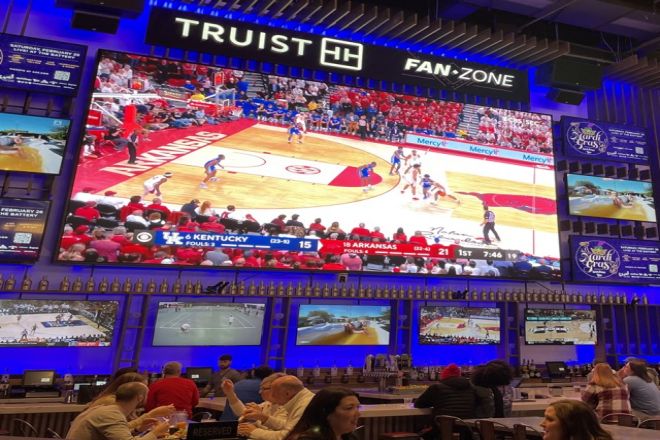
Live broadcasts have become an indispensable part of modern life. Whether it is chasing the exciting moments of sports events or immersing in the artistic world of literary and artistic performances, live broadcast content can always make us feel like we are there.
But have you ever thought about watching these live broadcasts in a more shocking and vivid way? The شاشة عرض LED is the key to opening the door to a new world. This article will directly take you to appreciate the unique charm of LED display screens in broadcasting live content and tell you how to enhance the viewing experience through LED display screens and enjoy an unprecedented visual feast.
There is no need for complex settings; just follow our guidance, and you can easily unlock a new realm of live viewing!
1. What are the quality requirements for LED display screens for synchronous live broadcasting?
The quality requirements for LED display screens for synchronous broadcasting live broadcasts mainly include the following aspects:
1). Use a synchronized player
This is the most important point. If you want to use your LED display screen to broadcast a football game live, you must use a synchronized player. Asynchronous broadcasting cannot be performed.
2) عالية دقة
High resolution can present more delicate and clear images and text, which is essential for the display of details in live content.
Especially when it is necessary to display product details, anchor expressions or sports scenes, high resolution can ensure that the audience has an excellent visual experience.
Generally speaking, the resolution should be at least 2K, and even 4K or higher resolution display screens can be considered. This will not only clearly display the live content but also ensure the clarity and fineness of the image.
3) عالية سطوع والتباين
- سطوع:
The brightness of the LED display needs to be determined according to the installation environment. For indoor environments, a brightness of 600 — 800cd/m² is more appropriate; in outdoor environments, it needs to reach 1500 — 3000cd/m² to ensure that the picture is still clearly visible under strong light.
High brightness helps to overcome the interference of ambient light and maintains the clarity and color reproduction of the picture.
- مقابلة:
Contrast refers to the ratio of the brightest area to the darkest area when displaying an image. High contrast can enhance the layering and three-dimensional sense of the image, making the picture brighter and the colors more vivid.
Generally speaking, the higher the contrast, the better, but the comprehensive influence of other parameters must also be considered in the actual selection.
4). Wide زاوية الرؤية
A wide viewing angle can ensure that viewers in different positions can see clear and consistent pictures, avoiding color and brightness deviations. This is especially important for large live broadcast rooms or occasions with a large number of viewers.
Usually, LED display screens should have a large viewing angle (such as horizontal and vertical viewing angles of more than 160°) to ensure that viewers can get a good viewing experience from all angles.
5) عالية معدل التحديث
High refresh rate can reduce the flickering and smearing of the picture, making the dynamic picture smoother. This is especially important for showing fast-moving scenes or product demonstrations.
Generally speaking, the refresh rate of LED display screens should reach or exceed 120Hz or even higher (such as 144Hz, 165Hz, etc.) to ensure that the audience can feel the continuity and smoothness of the picture when watching the live broadcast.
6). Stability and reliability
Synchronous live broadcast requires LED display screens to have high Stability and reliability to avoid failures or interruptions during the live broadcast.
Choose brands and products with reliable quality and good Stability to reduce the frequency of failures and repairs. At the same time, attention should be paid to detail processing during installation and debugging to ensure that the equipment connection is stable and reliable and the heat dissipation is good.
2. How to connect the LED display screen to live broadcast via computer?
To connect the LED display screen to live broadcast and achieve synchronous control via computer, you can mainly follow the following steps:
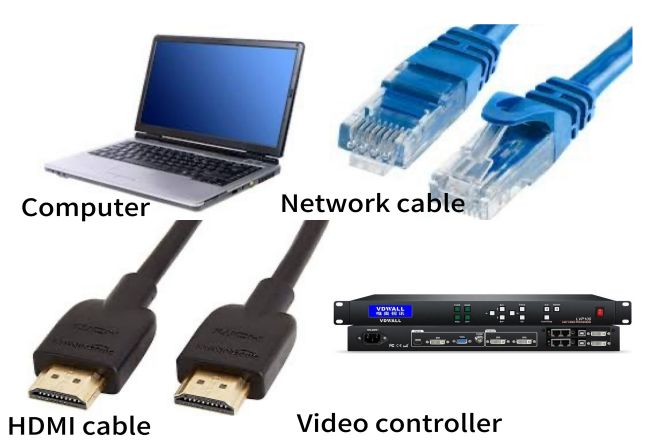
1). تحضير
1.1). Equipment selection:
Choose a suitable LED display screen to ensure that its resolution, brightness, contrast and other parameters meet the requirements of live broadcast.
Prepare a computer with stable performance as the playback and control center of the live broadcast content.
According to the interface type of the computer and LED display screen, prepare the corresponding connection cables, such as HDMI cable and network cable.
1.2). Environment layout:
Ensure that the LED display screen is installed firmly and at a suitable viewing angle and height.
Check the light, temperature and other conditions of the viewing environment to ensure that the audience can watch the live broadcast content comfortably.
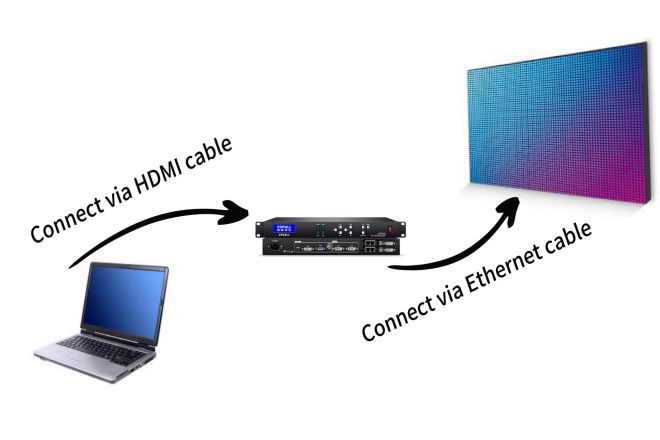
2). Connecting equipment
- Connecting the video processor from the computer uses an HDMI connection:
If both the computer and the LED display screen support the HDMI interface, the HDMI cable is preferred for connection.
Plug one end of the HDMI cable into the HDMI output interface of the computer and the other end into the HDMI input interface of the LED display screen.
Then, start the computer and LED display screen, and select the signal source according to the prompts of the display screen (usually select HDMI mode).
- The connection from the video processor to the LED display is made by using a network cable:
For the application of LED display, Ethernet cables such as CAT5e or CAT6 are usually selected, as they have high data transmission rates and good anti-interference capabilities.
Plug one end of the network cable into the network port of the video processor and the other end into the network port of the LED display (or transfer through a network device such as a switch).
Make sure that the video processor and the LED display are in the same network segment so that they can communicate with each other. This usually involves setting network parameters such as IP address and subnet mask.
3). Settings
After connecting the computer and the LED display, because your LED display is a synchronous control system, your LED display will display what the computer displays.
At this time, you just need to open the live broadcast software and select the live broadcast of the football game you need to play.
4). Testing and optimization
4.1). System test:
Perform system testing before the official live broadcast, including Testing of video playback, audio output, and picture synchronization.
Ensure that all devices are working properly and compatible with each other without conflict.
4.2). Optimization and adjustment:
Make necessary optimization adjustments based on the test results, such as adjusting the settings of the playback software, changing the connection cable, etc.
Ensure that the picture is clear and smooth and the sound is clear and noise-free during the live broadcast.
3. Precautions when using LED display screens for live broadcast viewing
When using LED display screens for live broadcast viewing, you need to pay attention to the following aspects to ensure the smooth progress of the live broadcast and a good experience for the audience:
1). Choose the right LED display screen:
Choose an LED display screen with appropriate resolution, brightness, contrast, and other parameters according to the live broadcast content and viewing distance.
For example, for live broadcasts of sports events, you may need to choose a high-definition full-color screen to ensure a clear picture, while for educational lectures, a simple and elegant single-color or two-color screen may be more suitable.
Make sure that the size and resolution of the LED display screen can meet the needs of live broadcasts to avoid blurry or distorted pictures.
2). Correctly install the LED display screen:
Fix the LED display screen on a stable bracket or background wall to ensure that it will not shake or fall off during the live broadcast.
Adjust the tilt angle and height of the display screen so that the audience can watch the live broadcast content comfortably.
3). Ensure a stable signal:
Use high-quality cables (such as HDMI cables, optical fibers, etc.) to connect the LED display screen to the video processor or live broadcast device.
Check whether the signal cable is firmly connected to avoid signal interruption or interference.
4). Debugging display effects:
Adjust the brightness, color, contrast, and other parameters of the LED display to ensure that the picture display effect is excellent and not dazzling.
Check whether there are any pixel damage or display abnormalities, and repair them in time.
4. Practical application of LED display screens for watching live broadcast content
LED display screens have shown wide applicability and strong expressiveness in the practical application of watching live broadcast content. The following is a detailed description of several specific application scenarios:
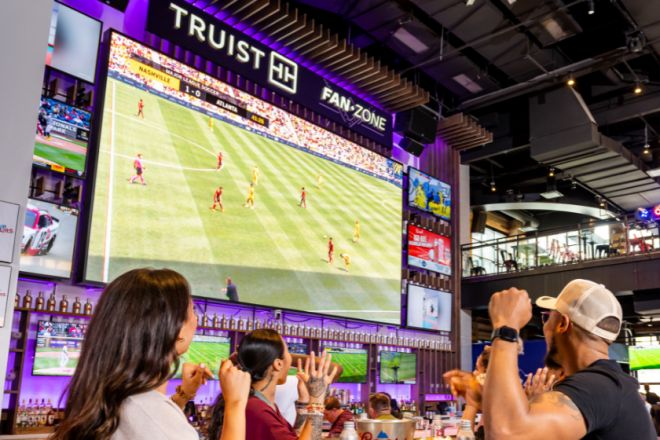
1). Live broadcast of رياضات الأحداث
In sports events, LED display screens have become an important bridge connecting the scene and the audience. Through high-definition, large-screen LED display screens; the audience can watch the game screen in real-time and not miss any exciting moments.
Combined with on-site commentary and interactive links, such as real-time score updates, player data statistics, audience voting, etc., LED display screens bring a more immersive viewing experience to the audience.
In addition, in large-scale sports events, LED display screens can also be used to play إعلانات, event previews, and sponsor information, creating additional commercial value for event organizers.
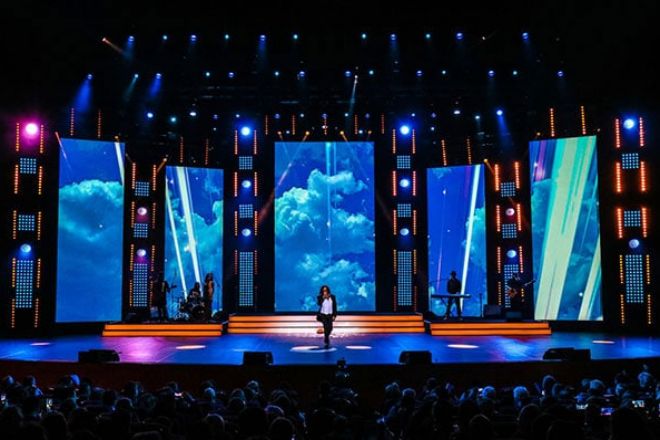
2). Art performances and concerts
In art performances and concerts, the application of LED display screens has greatly enriched the منصة effects and audience experience.
As a stage background, the LED display can play video materials related to the theme of the performance, such as the dreamy starry sky, the flowing sea of clouds, etc., to create a unique visual effect.
At the same time, it can also display the performance screen in real-time, such as the close-up of the singer, the performance scene of the band, etc., so that the audience seems to be in the performance.
In addition, the LED display can also cooperate with stage equipment, such as lighting and sound, to achieve a more exciting stage effect and enhance the artistic appeal and viewing of the performance.
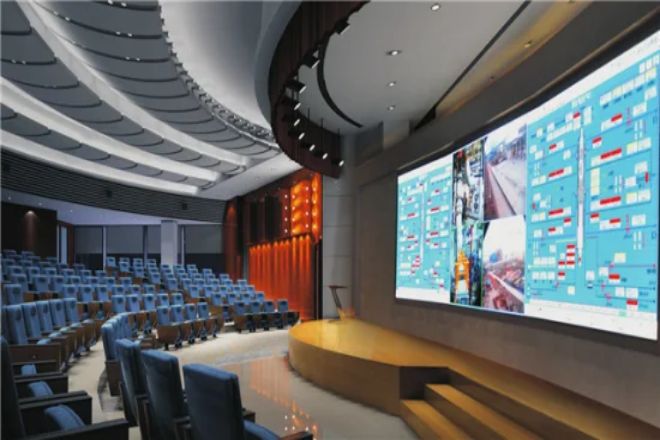
3). Online تعليم والتدريب
In educational institutions and corporate training, the application of LED display screens has brought revolutionary changes to teaching and learning.
By showing live courses or lectures, LED display screens make remote teaching possible, breaking the limitations of time and space. Students or employees can watch live courses through the Internet at any location and interact with lecturers in real-time.
At the same time, the high definition and large screen of the LED display screen make the teaching content more intuitive and easy to understand, improving the teaching effect and learning experience.
In addition, the LED display screen can also be used to play teaching videos, PPT presentations, and other auxiliary teaching materials to enrich teaching methods and content.
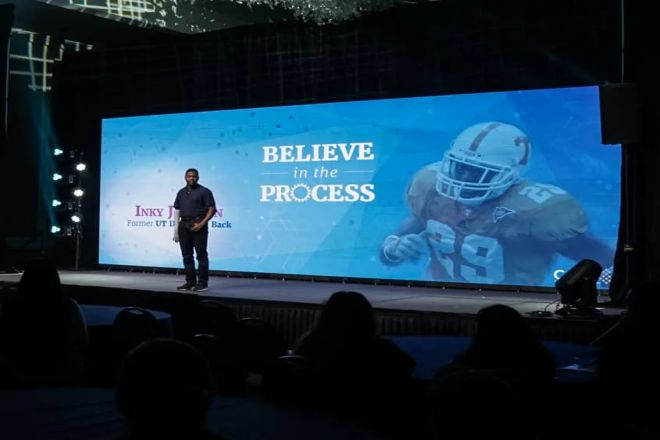
4). Commercial activities and المعارض
In various commercial activities and exhibitions, LED display screens have become an important tool to attract audience attention and enhance brand image.
By playing brand promotional videos, product introductions, and live broadcasts, LED displays can quickly attract the audience’s attention and convey the company’s brand image and product information. Especially at large exhibitions, the flexibility and customizability of LED displays allow companies to display and promote according to their own needs.
At the same time, LED displays can also interact with the audience, such as scanning codes to follow, participating in lucky draws, and other activities to enhance the audience’s sense of participation and experience.
خاتمة
In summary, LED displays have played an important role in watching live broadcast content with their unique advantages, not only bringing an unprecedented visual feast to the audience but also greatly enhancing the immersiveness and interactivity of viewing.
Through reasonable selection and configuration, optimizing content quality, and enhancing interactivity, we can further tap the potential of LED displays and create a more exciting and comfortable viewing experience for the audience.
أخيرًا، إذا كنت تريد معرفة المزيد عن شاشات LED، يرجى الحصول على اتصال معنا.
